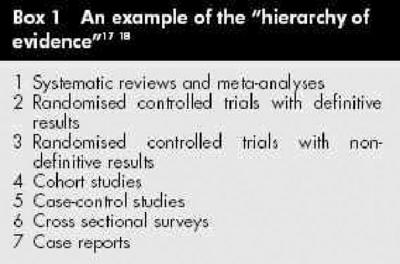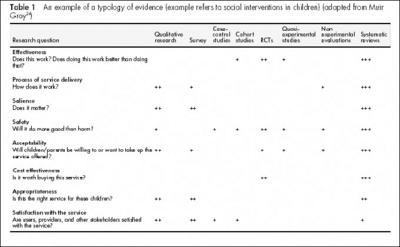Deciding on how to value evidence will also help to guide the rest of your scoping. If a traditional hierarchy of evidence is going to be used (see diagram below) there's not much point in collecting "lay opinion".

But if a typology of evidence approach (below) is used community views may be important in aswering questions of appropriateness and acceptability. What is often dismissed as "lay opinion" may be quite valuable because it (a) comes from a different knowledge and values base than other types of evidence, (b) is important in determining outcomes and (c) may offer unique insights.

NB: both digrams are from Petticrew M, Roberts H. Evidence, Hierarchies and Typologies: horses for courses, Journal of Epidemiology & Community Health, 57:527-9, 2003. Link to Fulltext)
It's also important to realise that agreeing on how evidence will be valued doesn't predetermine what the assessed impacts will be. It's about ensuring clarity of purpose:
- Will you HIA have a broad of tight focus?
- Will it focus on health protection, health promotion or both?
- Will it be used as a political or scientific tool?
Resources that might be of use: (more)
NHMRC. Using Socioeconomic Evidence in Clinical Practice Guidelines, National Health & Medical Research Council: Canberra, 2002.
This handbook provides information to assist developers of clinical practice guidelines (CPGs) in summarising the evidence of the effects of socioeconomic position (SEP) and other markers (or descriptors) of disadvantage, on health outcomes and health care delivery. This process informs the development of CPGs by suggesting ways in which guideline developers can identify and retrieve evidence and incorporate it into guidelines for clinical practice.
Weightman A, Sander L, Turley R, Ellis S, Cullum A. Grading evidence and recommendations for public health interventions: Developing and piloting a framework, Support Unit for Research Evidence (SURE), Information Services, Cardiff University & the Health Development Agency, London, 2005.
“This provisional framework provides a practical and transparent method for deriving grades of recommendation for public health interventions, based on a synthesis of all relevant supporting evidence from research.”
"..The framework was to relate only to the grading of evidence and recommendations for public health interventions. (The types of evidence that are relevant to other (non-intervention) aspects of public health will be included in further developments of the methodology.) Development of the framework has incorporated an analysis of the published literature on deriving grades of evidence and recommendations for public health interventions, and consultation with public health and methodology experts.


0 comments:
Post a Comment